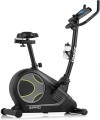The type of power source used in the exercise bike.
—
Mains. Powered by a standard 230 V power supply. Such power allows you not to worry about replacing or recharging dead batteries — the exercise bike will work as long as there is electricity in the house. In addition, it is suitable for models with any load system, even electromagnetic (for more details, see "Load system"), while such devices are much cheaper than models with generators (see below). The main disadvantages are the dependence on the outlet and the need to use wires, which can limit mobility and get in the way. However, these shortcomings do not cause significant inconvenience.
—
Battery. The exercise bike is powered by replaceable batteries. The main advantage such exercise bikes can be installed anywhere without worrying about the availability of sockets and laying the power cord. On the other hand, the power of the batteries is very limited, and they are only suitable for models with mechanical or magnetic load systems (see "Load system" for more details), where power is required only for the computer. In addition, the battery life is not infinite, and they need to be changed or recharged periodically.
— Built-in generator. The exercise bike is powered by its built-in generator, which is driven by the rotation of the flywheel. In other words, when using such a model, the user himself generates the energy
...required for work. To turn on the exercise bike with a built-in generator, is enough to turn the flywheel several times. This type of power supply combines the advantages of the two above. On the one hand, it is autonomous, on the other hand, it has sufficient power even to provide energy to electromagnetic load systems (for more details, see "Load system"). At the same time, this feature significantly increases the weight, and most importantly, the cost of the device, and therefore is found only in premium models.
